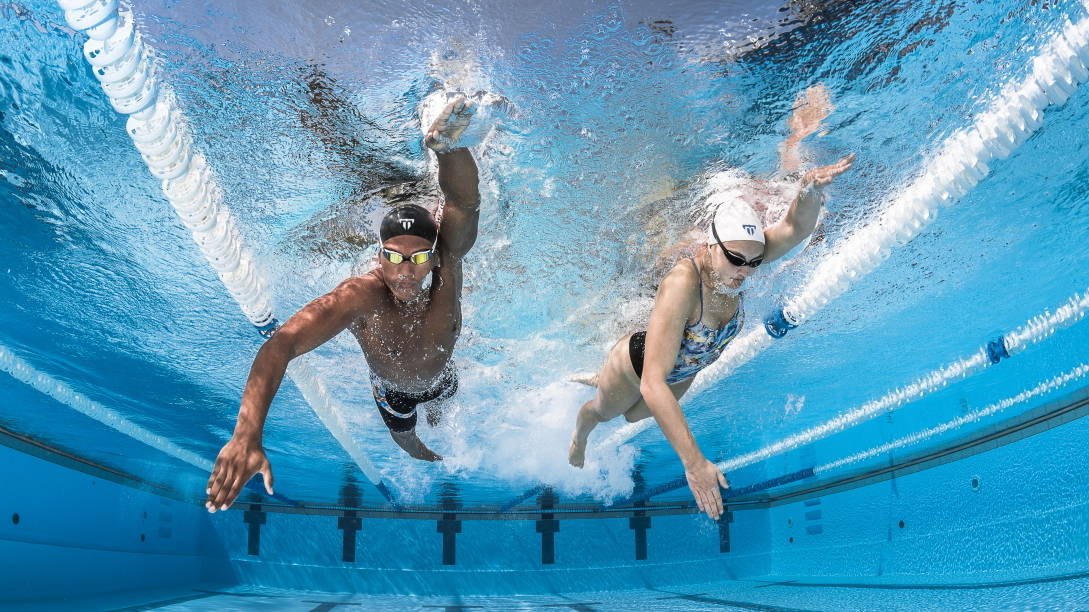Beim Schwimmen ist vor allem das Schultergelenk durch die verschiedenen Schwimmstile wie Kraul, Delphin, Rücken und Brust der größen Belastungsintensität ausgesetzt. Überlastung und unfunktionelle Belastung (zumeist durch falsche Technik) können schnell Schmerzen in dieser komplexen Gelenkstruktur verursachen. Orthopäde und Sportmediziner Uli Nieper zeigt in diesem Beitrag Ursachen und Behandlungsmöglichkeiten der sog. Schwimmschulter auf.
Rund 30-50% aller Leistungsschwimmer und Triathleten geben an, mindestens einmal an einer sogenannten Schwimmerschulter gelitten zu haben. Dieser Begriff ist hierbei keine korrekte medizinische Bezeichnung, sondern fasst mehrere Verletzungen im Schulterbereich zusammen, die sowohl einzeln als auch kombiniert auftreten können.
Bei falscher Technik und zu schneller und hoher Umfangssteigerung kommt es zu Überlastungserscheinung bestimmter anatomischer Strukturen und schmerzhaften Entzündungen. Auch einseitiges Training und zu wenig Gymnastik- und Dehnübungen können muskuläre Dysbalancen (Kräfteungleichgewicht) der verschiedenen Muskelgruppen mit sich bringen. Eine Instabilität des Schultergelenks durch jahrelanges Training mit wiederkehrender Aufdehnung der Schultergelenkkapsel (diese hält den Oberarmkopf mit der Schultergelenkpfanne zusammen) kann auch zu belastungsabhängigen Schmerzen führen.
Impingement-Syndrom: Schmerzen in Schleimbeutel und Sehne
Die am häufigsten auftretende Verletzung beim Schwimmsport, vor allem beim Kraulen und Delphinschwimmen ist das sogenannte Impingement-Syndrom. Hierbei führt das maximale Heben (Abduktion) und Außendrehen des Armes dazu, dass der Schleimbeutel zwischen Oberarmkopf und Schulterdach (Acromion) zusammen mit Sehnen des Supraspinatusmuskels (abduziert den Arm ganz nach oben) leicht eingeklemmt wird. Zu lange Trainingsstrecken oder zu schnelle Intensitätssteigerung kombiniert mit schlechter Technik führen auch zusätzlich zu Entzündungen des Schleimbeutels oder der Supraspinatussehne. Eine zu hohe Belastung mit übergroßen Paddles kann diese Symptomatik noch verstärken.
Nur begrenzt mit Paddles trainieren
Der wichtige erste Schritt nach der Diagnosestellung ist die Korrektur der Technik durch einen Trainer und die Reduzierung des Trainingsumfangs. Häufig reicht hier schon das Einstellen des Paddle-Schwimmens und grundsätzlich gilt, dass dieses maximal 20% des gesamten Trainingsumfangs einnimmt. Auch sollten die Paddles nicht zu groß gewählt werden.
Häufiges Problem: der falsche Bewegungsablauf
Auch hier sind Kraul- und Delphin-Stil wieder besonders anfällig. Der Arm wird am Ende der Streckphase erst maximal abduziert und dann nach außen rotiert und beim Zurückführen (Adduktion) in die Zugphase nach innen gedreht (Innenrotation).
Dieser Bewegungsablauf trainiert fast nur die Innenrotationsmuskeln und die Brustmuskulatur (z.B. musculus pectoralis), während die Gegenspieler - Außenrotationsmuskeln am Rücken und Schulterblatt (z.B. musculus trapezius) oder der hintere Anteil des Deltamuskels (musculus deltoideus) - verkümmern.
Krafttraining nur in Maßen
Oft wird beim Krafttraining nur die, durch das Schwimmen bereits mehr gestärkte, Brustmuskulatur weiter trainiert, wodurch die Innenrotatoren zusätzlich verkürzt werden. Das Ungleichgewicht der Kräfte und die verkürzte Muskulatur führt dann zu einer veränderten Mechanik im Schultergelenk. Der Oberarmkopf wird falsch im Gelenk geführt und läuft nicht mehr zentriert in der Schultergelenkspfanne. Dadurch drückt er vermehrt gegen das Schulterdach und reizt die Schleimbeutel und die Supraspinatussehne weswegen es wieder zum Eintreten es schmerzhaften Impingementsyndroms kommt.
Beseitigung von einseitigem Training
Proportional mit der im Wasser verbrachten Trainingszeit sollte auch die Dauer des Dehnens und der Gymnastik steigen. Die tägliche Kräftigung der Rückenmuskulatur und der Außenrotatoren verhindert noch etwaige Dysbalancen und kann durch Übungen mit dem Gummiband (auch THERA-Band genannt) erreicht werden.
Dysbalancen nicht ignorieren
Während Dysbalancen durch gezieltes Training noch auszugleichen sind, ist eine chronische Instabilität des Schultergelenks schwer zu therapieren. Unbehandeltes Kräfteungleichgewicht führt dabei zur Überdehnung der Schultergelenkkapseln mit ihren Bandanteilen (Ligamenta glenohumeralia), weswegen der Oberarmkopf nicht mehr stabil in der Schultergelenkspfanne sitzt. Die Folge ist das einseitige Aufbrauchen und -dehnen der Knorpellippe (Labrum), die den Oberarmkopf normalerweise stabilisieren soll. Das Labrum kann dann einreißen oder abgeschert werden. Medizinisch spricht man hierbei von einer SLAP-Läsion, die je nach Größe des Risses in mehrere Schweregrade einteilbar ist. Bemerkbar macht sie sich beim Sportler durch das “Schnappphänomen” beim bewegen der Schulter, welches meist mit Schmerzen einher geht. Auch hier führt die Instabilität wieder zum Impingementsyndrom, allerdings ist eine SLAP-Läsion durch klinische Untersuchungen versierter Mediziner diagnostizierbar. Bei Verdacht ist auch eine zusätzliche kernspintomographische Untersuchung empfehlenswert.
Letzte Option: Die Operation
Wird die “Schwimmerschulter” diagnostiziert, sollte der erste Schritt gezielte sportphysiotherapeutische Behandlung kombiniert mit Muskelaufbautraining sein. Auch eine Trainingspause und/oder Reduzierung/Änderung der Trainingsinhalte ist hierbei selbstverständlich. Bleiben diese Maßnahmen trotzdem erfolglos bleibt nur noch die Operation. Hierbei kann ein arthroskopischer Eingriff das Labrum wieder stabilisieren und befestigen und auch eine aufgedehnte Schultergelenkkapsel kann wieder gestrafft werden. So ein Eingriff sollte aber nur in einem Spezialzentrum für Schulterarthroskopien von routinierten Operateuren durchgeführt werden. Die Diagnosestellung sollte um auf der sicheren Seite zu sein durch einen Orthopäden oder Sportmediziner erfolgen, der sowohl beide Schwimmstile und die dazugehörigen Bewegungen kennt und versteht, als auch sicher in der Schulteruntersuchung ist. Sind die Beschwerden bereits über einen langen Zeitraum vorhanden kann auch hier eine kernspintomographische Untersuchung helfen um Fehldiagnosen zu vermeiden.
Abschließender Tipp vom Experten
Treten erstmalig Schulterschmerzen im Training auf, sollten diese nicht ignoriert, sondern ernst genommen werden. Macht sofort eine kurze Pause, dehnt euch und macht danach locker weiter. Wenn der Schmerz dann immer noch vorhanden ist, brecht das Training am besten für heute ab und legt eine mehrtägige Pause ein. Während dieser Übung solltet ihr die oben genannten Übungen zur Kräftigung der Außenrotatoren durchführen und erst danach wieder, anfangs mit geringer Intensität und Umfang mit dem Training weiter machen.
Nicht verpassen: nur dieses Wochenende 09./10.03.




















